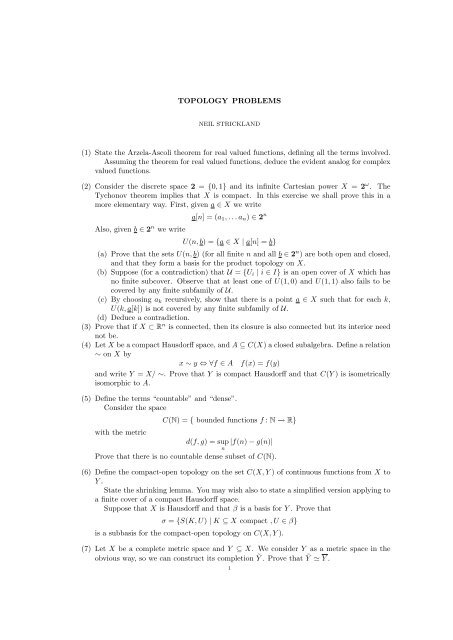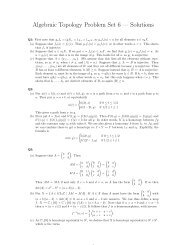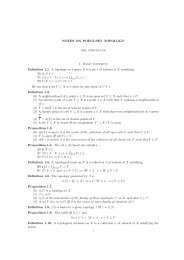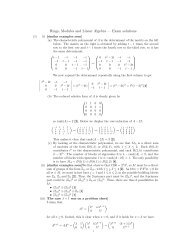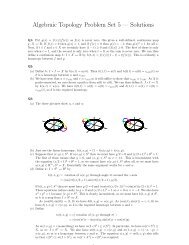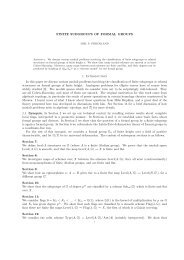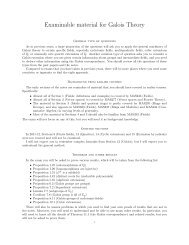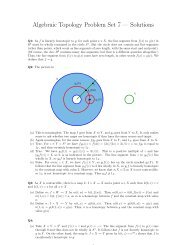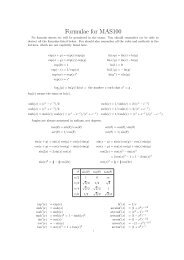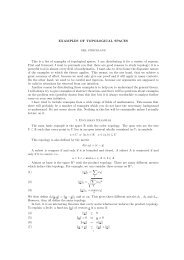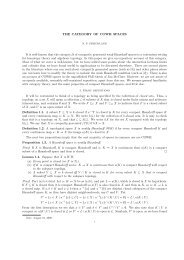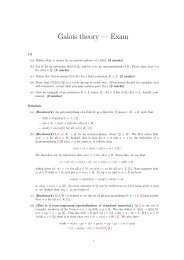TOPOLOGY PROBLEMS (1) State the Arzela-Ascoli ... - Neil Strickland
TOPOLOGY PROBLEMS (1) State the Arzela-Ascoli ... - Neil Strickland
TOPOLOGY PROBLEMS (1) State the Arzela-Ascoli ... - Neil Strickland
Create successful ePaper yourself
Turn your PDF publications into a flip-book with our unique Google optimized e-Paper software.
<strong>TOPOLOGY</strong> <strong>PROBLEMS</strong><br />
NEIL STRICKLAND<br />
(1) <strong>State</strong> <strong>the</strong> <strong>Arzela</strong>-<strong>Ascoli</strong> <strong>the</strong>orem for real valued functions, defining all <strong>the</strong> terms involved.<br />
Assuming <strong>the</strong> <strong>the</strong>orem for real valued functions, deduce <strong>the</strong> evident analog for complex<br />
valued functions.<br />
(2) Consider <strong>the</strong> discrete space 2 = {0, 1} and its infinite Cartesian power X = 2 ω . The<br />
Tychonov <strong>the</strong>orem implies that X is compact. In this exercise we shall prove this in a<br />
more elementary way. First, given a ∈ X we write<br />
Also, given b ∈ 2 n we write<br />
a[n] = (a 1 , . . . a n ) ∈ 2 n<br />
U(n, b) = {a ∈ X | a[n] = b}<br />
(a) Prove that <strong>the</strong> sets U(n, b) (for all finite n and all b ∈ 2 n ) are both open and closed,<br />
and that <strong>the</strong>y form a basis for <strong>the</strong> product topology on X.<br />
(b) Suppose (for a contradiction) that U = {U i | i ∈ I} is an open cover of X which has<br />
no finite subcover. Observe that at least one of U(1, 0) and U(1, 1) also fails to be<br />
covered by any finite subfamily of U.<br />
(c) By choosing a k recursively, show that <strong>the</strong>re is a point a ∈ X such that for each k,<br />
U(k, a[k]) is not covered by any finite subfamily of U.<br />
(d) Deduce a contradiction.<br />
(3) Prove that if X ⊂ R n is connected, <strong>the</strong>n its closure is also connected but its interior need<br />
not be.<br />
(4) Let X be a compact Hausdorff space, and A ⊆ C(X) a closed subalgebra. Define a relation<br />
∼ on X by<br />
x ∼ y ⇔ ∀f ∈ A f(x) = f(y)<br />
and write Y = X/ ∼. Prove that Y is compact Hausdorff and that C(Y ) is isometrically<br />
isomorphic to A.<br />
(5) Define <strong>the</strong> terms “countable” and “dense”.<br />
Consider <strong>the</strong> space<br />
C(N) = { bounded functions f : N −→ R}<br />
with <strong>the</strong> metric<br />
d(f, g) = sup |f(n) − g(n)|<br />
n<br />
Prove that <strong>the</strong>re is no countable dense subset of C(N).<br />
(6) Define <strong>the</strong> compact-open topology on <strong>the</strong> set C(X, Y ) of continuous functions from X to<br />
Y .<br />
<strong>State</strong> <strong>the</strong> shrinking lemma. You may wish also to state a simplified version applying to<br />
a finite cover of a compact Hausdorff space.<br />
Suppose that X is Hausdorff and that β is a basis for Y . Prove that<br />
σ = {S(K, U) | K ⊆ X compact , U ∈ β}<br />
is a subbasis for <strong>the</strong> compact-open topology on C(X, Y ).<br />
(7) Let X be a complete metric space and Y ⊆ X. We consider Y as a metric space in <strong>the</strong><br />
obvious way, so we can construct its completion Ỹ . Prove that Ỹ ≃ Y .<br />
1
2 NEIL STRICKLAND<br />
(8) Fix α with 0 < α < 1 and let X be <strong>the</strong> set of contraction mappings f : [0, 1] −→ [0, 1] of<br />
ratio α. Prove that X is compact. Prove that <strong>the</strong> function<br />
F : X −→ [0, 1]<br />
F (f) = <strong>the</strong> unique fixed point of f<br />
is continuous (this has nothing to do with <strong>the</strong> compactness).<br />
(9) Let X be a nonempty complete metric space. A contraction mapping on X with ratio<br />
α < 1 is a function f : X −→ X such that<br />
d(f(x), f(y)) ≤ αd(x, y)<br />
A fixed point of f is a point x ∈ X such that f(x) = x. Prove (by considering <strong>the</strong> sequence<br />
of iterates f k (a) = f(f(. . . (a)))) that a contraction mapping has a unique fixed point. If<br />
a is an arbitary point and b is <strong>the</strong> fixed point, prove that<br />
d(a, b) ≤ d(a, f(a))/(1 − α)<br />
(10) Let A ⊂ R n be a compact convex set, and suppose that 0 is in <strong>the</strong> interior of A. Convexity<br />
means that whenever u and v lie in A, <strong>the</strong> line segment [u, v] = {tu + (1 − t)v | 0 ≤ t ≤ 1}<br />
joining <strong>the</strong>m lies wholly in A (draw some pictures).<br />
(a) Suppose that 0 ≠ a ∈ A. Prove that <strong>the</strong> line segment<br />
(0, a) = {ta | 0 < t < 1}<br />
lies in <strong>the</strong> interior of A.<br />
(b) Prove that <strong>the</strong> map bdy(A) −→ S n−1 sending u to u/‖u‖ is a homeomorphism (where<br />
bdy(A) is <strong>the</strong> boundary of A).<br />
(11) <strong>State</strong> <strong>the</strong> Baire category <strong>the</strong>orem, in a form involving closed or nowhere-dense sets.<br />
You may assume <strong>the</strong> following (intuitively reasonable) fact:<br />
Suppose that X ⊆ R 2 is connected and x ∈ int(X). Then X \ {x} is connected.<br />
Suppose that f : [a, b] −→ R is continuous and injective. Prove that int(f([a, b])) = ∅.<br />
Deduce that <strong>the</strong>re is no continuous bijection R −→ R 2 .<br />
(12) Let (X, d) be a metric space. Given a closed subset Y ⊆ X and a point x ∈ X, write<br />
d(x, Y ) = inf{d(x, y) | y ∈ Y }.<br />
(a) Prove that d(x, Y ) = 0 if and only if x ∈ Y .<br />
(b) Prove that d(x, Y ) is continuous as a function of x.<br />
(c) Prove that <strong>the</strong> function<br />
e(a, b) = min(d(a, b), d(a, Y ) + d(b, Y ))<br />
is a pseudometric on X.<br />
(d) Prove that if Y and Y ′ are disjoint closed subsets of X <strong>the</strong>n <strong>the</strong>re are disjoint open<br />
sets U and U ′ with Y ⊆ U and Y ′ ⊆ U ′ .<br />
(13) A subset Y ⊂ X is said to be dense in X if <strong>the</strong> closure of Y in X is <strong>the</strong> whole of X.<br />
(a) Give an example of a countable dense subset of R.<br />
(b) Prove that two continuous functions f and g from R to R which agree on a dense set<br />
are equal.<br />
(c) Suppose that f : R −→ R is continuous and that f(x) + f(y) = f(x + y) for all x and<br />
y in R. Prove that f(x) = f(1)x for all x.<br />
(14) Suppose X is a metric space and A ⊆ C(X). Say that A is equilipschitz if <strong>the</strong>re is a<br />
constant K such that<br />
|f(x) − f(y)| ≤ Kd(x, y)<br />
for all x, y ∈ X and f ∈ A. Prove that this implies that A is equicontinuous.<br />
(15) Let X be a space, A a subset of C(X). For any open set V we can ask whe<strong>the</strong>r <strong>the</strong> set<br />
A| V is equicontinuous. Show that <strong>the</strong>re is a largest open set U for which this is true.
<strong>TOPOLOGY</strong> <strong>PROBLEMS</strong> 3<br />
Consider <strong>the</strong> case X = R and A = {f n | n ≥ 2} where f n (x) = x n . Show that<br />
U = (−1, 1). You may assume (or prove, if you’re feeling enthusiastic) that for 0 < r < 1<br />
and n ≥ 2 we have<br />
nr n−1 ≤ 2/(r −1 − 1)<br />
(16) Find examples of <strong>the</strong> following situations:<br />
(a) A set X ⊂ R which is equal to its boundary.<br />
(b) A set X ⊂ R which is not <strong>the</strong> closure of its interior.<br />
(c) A set X ⊂ R which is <strong>the</strong> interior of its closure.<br />
(d) A set X ⊂ Q which is both open and closed in Q.<br />
(e) An infinite, bounded, closed set X ⊂ R with empty interior.<br />
(f) Subsets X, Y ⊂ R with X ∩ Y ≠ X ∩ Y<br />
(g) A sequence of open sets U n ⊂ R for n ∈ N whose intersection is not open.<br />
Define <strong>the</strong> terms “compact” and “Hausdorff”.<br />
Let X be a compact Hausdorff space. Consider <strong>the</strong> set<br />
A = C(X, [0, 1]) = { continuous functions f : X −→ [0, 1]}<br />
Define <strong>the</strong> usual topology on A.<br />
Suppose that A is compact. Prove that X is finite.<br />
(17) (18) For this question we use <strong>the</strong> notation<br />
iA = interior of A<br />
kA = closure of A<br />
cA = complement of A<br />
It is interesting to ask what sets we can get by starting with a given set A and repeatedly<br />
applying <strong>the</strong> operators i, k, and c.<br />
(a) “Simplify” <strong>the</strong> following expressions:<br />
ccA kkA iiA cicA ckcA<br />
(b) Prove that if A is <strong>the</strong> closure of some open set U, <strong>the</strong>n A = kiA.<br />
(c) Prove that kikiA = kiA for any A, and hence that ikikB = ikB for any B.<br />
(d) Prove that for any set A, at most fourteen different sets (including A itself) can be<br />
obtained from A by repeatedly applying <strong>the</strong> operations i,k, and c. Seven of <strong>the</strong>se are<br />
“roughly <strong>the</strong> same as A” and <strong>the</strong> o<strong>the</strong>r seven “roughly <strong>the</strong> same as cA”.<br />
(e) Find a subset A ⊂ R such that all fourteen of <strong>the</strong>se sets are different. Hints: If you<br />
take care of <strong>the</strong> first seven, <strong>the</strong> o<strong>the</strong>r seven will probably take care of <strong>the</strong>mselves. You<br />
will want to build A out of several different chunks spaced out along <strong>the</strong> real line.<br />
(19) Now write<br />
bA = boundary of A = kA ∩ kcA<br />
(a) “Simplify” <strong>the</strong> following expressions:<br />
k(A ∪ B) i(A ∩ B) c(A ∩ B) A ∩ (B ∪ C) bcA kbA<br />
(b) Prove that if A is closed, <strong>the</strong>n ibA = ∅, and thus that b 2 A = bA.<br />
(c) Prove that b 3 A = b 2 A for any set A.<br />
(d) Find a set A ⊂ R with A ≠ bA ≠ b 2 A.<br />
(e) What does it mean to have bA = ∅ ?<br />
(20) Prove that if X is Hausdorff <strong>the</strong>n every finite subset (in particular, every set consisting of<br />
a single point) is closed.<br />
Let Y be <strong>the</strong> set C[0, 1] of continuous functions f : [0, 1] −→ R from <strong>the</strong> closed unit<br />
interval to R. We regard Y itself as a topological space, with <strong>the</strong> topology coming from<br />
<strong>the</strong> following metric:<br />
d(f, g) =<br />
∫ 1<br />
0<br />
|f(x) − g(x)|dx
4 NEIL STRICKLAND<br />
(you may assume that this is a metric and not merely a pseudometric). Prove that Y is<br />
Hausdorff.<br />
Define an equivalence relation ∼ on Y by<br />
f ∼ g ⇔ ∃ɛ > 0 ∀x ∈ [0, ɛ]<br />
f(x) = g(x)<br />
In o<strong>the</strong>r words, f and g are equivalent iff <strong>the</strong>y agree on some interval [0, ɛ] with ɛ > 0.<br />
We write 1 for <strong>the</strong> constant function with value 1 and so on. Show that for any δ > 0<br />
<strong>the</strong>re is a function f ∈ Y such that f ∼ 1 but d(f, 0) < δ.<br />
Conclude that in <strong>the</strong> quotient space X = Y/ ∼ (with <strong>the</strong> quotient topology, of course)<br />
0 and 1 cannot be separated by disjoint open sets. This means that X is not Hausdorff.<br />
It is actually indiscrete, but you need not prove this.<br />
(21) The graph of a function f : X −→ Y is <strong>the</strong> set<br />
Γ(f) = {(x, f(x)) | x ∈ X} ⊆ X × Y<br />
This is just <strong>the</strong> “rule” of f, in <strong>the</strong> terminology of section 1.2. Prove that if Y is Hausdorff<br />
and f is continuous <strong>the</strong>n Γ(f) is closed. Try to make it a slick proof. Find an example of<br />
a discontinuous function f : R −→ R with closed graph.<br />
(22) Define carefully <strong>the</strong> terms “quotient topology” and “one-point compactification”.<br />
Consider <strong>the</strong> spaces<br />
Define maps<br />
S 3 = {(z, w) ∈ C 2 | |z| 2 + |w| 2 = 1}<br />
S 2 = C ∞<br />
f : S 2 −→ S 2 f(z) = 1/z<br />
g : S 3 −→ S 2<br />
g(z, w) = z/w<br />
(with <strong>the</strong> usual conventions about 0 and ∞). Prove that f is a homeomorphism and that<br />
g is continuous. You may assume that <strong>the</strong> following maps are continuous:<br />
h = f| C\{0} : C \ {0} −→ C \ {0} h(z) = 1/z<br />
m: C × C −→ C m(z, w) = zw<br />
(23) This exercise has very little to do with topology, but it may help you understand ultrafilters.<br />
Let W be a free ultrafilter on N. Define an equivalence relation on <strong>the</strong> product space<br />
R N by<br />
a ∼ b iff {n ∈ N | a n = b n } ∈ W<br />
The quotient set R ∗ = R N / ∼ is called <strong>the</strong> field of hyperreal numbers. Define an order<br />
relation and algebraic operations on R ∗ as follows:<br />
[a] < [b] ⇔ {n | a n < b n } ∈ W<br />
[a] + [b] = [a + b]<br />
[a][b] = [ab]<br />
Here ab means <strong>the</strong> sequence with n’th term a n b n and so on. We shall confuse a real<br />
number x with <strong>the</strong> equivalence class of <strong>the</strong> constant sequence (x, x, . . .).<br />
(a) Prove that ∼ is an equivalence relation.<br />
(b) Prove that <strong>the</strong> order and <strong>the</strong> operations are well defined, so that if [a] = [a ′ ] and<br />
[b] = [b ′ ] <strong>the</strong>n [ab] = [a ′ b ′ ] etc.<br />
(c) Check that R ∗ is an ordered field, so it has properties (1) to (8) listed on pages 30–31<br />
of <strong>the</strong> book. You need only check a small random selection.<br />
(d) Say that a ∈ R ∗ is infinitesimal if −1/n < a < 1/n for every n ∈ Z + . Write I for <strong>the</strong><br />
set of infinitesimals. Show that [1, 1/2, 1/3, . . .] ∈ R ∗ is a nonzero infinitesimal.
<strong>TOPOLOGY</strong> <strong>PROBLEMS</strong> 5<br />
(e) Say that a ∈ R ∗ is finite if −n < a < n for some n ∈ Z + . Write F for <strong>the</strong> set of finite<br />
hyperreals. Write a ≃ b iff a − b ∈ I. Show that <strong>the</strong> composite<br />
is bijective.<br />
R −→ F −→ F/ ≃<br />
(24) Suppose that k : [0, 1] × [0, 1] −→ R is continuous. For fixed x we can consider k(x, y) as a<br />
function of y. More formally, define<br />
so<br />
k # (x)(y) = k(x, y)<br />
k # (x): [0, 1] −→ R<br />
Prove that k # (x) is continuous, so that k # (x) ∈ C(X) and thus<br />
k # : [0, 1] −→ C[0, 1]<br />
Prove that this map k # is continuous.<br />
Now define<br />
K : C[0, 1] −→ C[0, 1]<br />
(Ku)(x) =<br />
∫ 1<br />
0<br />
k(x, y)u(y)dy<br />
Prove that Ku is indeed continuous as is implicit in <strong>the</strong> notation. Prove that K is continuous.<br />
(25) Define <strong>the</strong> term “equicontinuous”.<br />
Let A be <strong>the</strong> space of continuous functions f : [0, 1] −→ R with <strong>the</strong> usual topology.<br />
Define a function K : A −→ A by<br />
(Kf)(t) =<br />
∫ 1<br />
0<br />
(s + t) 2 f(s)ds<br />
You may assume that Kf is continuous, so it lies in A as advertised. Prove that K is<br />
continuous.<br />
Let B be <strong>the</strong> unit ball:<br />
and V <strong>the</strong> eigenspace of eigenvalue 1:<br />
Prove that V ∩ B is compact.<br />
B = {f ∈ X | ‖f‖ ≤ 1}<br />
V = {f ∈ X | Kf = f}<br />
(26) Suppose that f : X −→ Y is continuous and surjective, and that X is locally connected.<br />
Need Y be locally connected ? Give a proof or counterexample.<br />
(27) (a) A topological manifold of dimension n is by definition a space M such that<br />
(i) M is Hausdorff<br />
(ii) M is second countable<br />
(iii) Every point x ∈ M has a neighbourhood U which is homeomorphic to R n (M<br />
is “locally euclidean”).<br />
For example, <strong>the</strong> sphere, <strong>the</strong> torus and <strong>the</strong> Möbius band are all two dimensional<br />
manifolds (you need not prove this).<br />
Show that an open subset of R n (and hence, of any manifold) is a manifold.<br />
(b) Show that <strong>the</strong> components of a manifold are path-connected manifolds.<br />
(c) Show that a manifold is locally compact, and hence (quoting a suitable <strong>the</strong>orem) that<br />
it is paracompact.<br />
(d) Give an example of a space satisfying parts (a) and (b) but not (c) of <strong>the</strong> definition<br />
of a manifold, and similarly for <strong>the</strong> o<strong>the</strong>r two cases.
6 NEIL STRICKLAND<br />
(28) Define<br />
M n = {n × n matrices of real numbers }<br />
GL n = { invertible matrices } ⊂ M n<br />
O n = {A ∈ GL n | A T = A −1 }<br />
SO n = {A ∈ O n | det(A) = 1}<br />
Where A T is <strong>the</strong> transpose of <strong>the</strong> matrix A. We topologise all <strong>the</strong>se spaces as subsets of<br />
M n ≃ R n2 , and we use <strong>the</strong> Euclidean norm on R n :<br />
( ) 1/2 ∑<br />
‖x‖ = x 2 k<br />
k<br />
The operator norm of a matrix A is defined as<br />
‖A‖ op = sup{‖Ax‖ | ‖x‖ ≤ 1}<br />
(a) Prove that <strong>the</strong> determinant map det: M n −→ R is continuous.<br />
(b) Prove that GL n is an open, disconnected subset of M n . (A harder problem is to<br />
prove that GL n has precisely two components).<br />
(c) Prove that SO 2 is homeomorphic to a circle.<br />
(d) Prove that O 3 is compact (= bounded and closed).<br />
(e) Prove that <strong>the</strong>re is a constant K (depending only on n) such that<br />
‖A‖ op ≤ K max{|A kl | | 1 ≤ k, l ≤ n} = K‖A‖ ∞<br />
(f) Prove that ‖A‖ op is a continuous function of A.<br />
(g) If you are prepared to use Rouché’s <strong>the</strong>orem from complex analysis, <strong>the</strong>n you can<br />
prove that <strong>the</strong> spectral radius r(A) is a continuous function of A:<br />
r(A) = max{|λ| | λ is an eigenvalue ofA}<br />
(29) Let f : C −→ C be a non-constant polynomial. You may assume <strong>the</strong> fact (proven in complex<br />
analysis) that f is open, surjective and (of course) continuous. Write<br />
U = {z ∈ C | |z| > 1}<br />
V = f ∗ (U) = {z ∈ C | |f(z)| > 1}<br />
This exercise shows that V is connected.<br />
(a) Let D ⊂ C be open. Prove that <strong>the</strong> connected components of D are open and closed<br />
in D.<br />
(b) Prove that if K ⊂ C is bounded and closed, <strong>the</strong>n <strong>the</strong> same is true of f(K).<br />
(c) Prove that <strong>the</strong>re are positive real constants K, L such that<br />
|f(z)| > L ⇒ |z| > K ⇒ |f(z)| > 1<br />
(d) Prove that V has precisely one unbounded component.<br />
(e) Suppose that W is bounded component of V . Prove using part (a) that f(W ) ∩ U =<br />
f(W ), and thus that f(W ) is open, closed and bounded in U. Deduce a contradiction<br />
and conclude that V is connected.<br />
(f) Prove that <strong>the</strong> complement of <strong>the</strong> Mandelbrot set is connected. This means that in<br />
some sense <strong>the</strong> Mandelbrot set has no holes, for a hole would be a bounded component<br />
of <strong>the</strong> complement. A reminder of <strong>the</strong> definition:<br />
q c (z) = z 2 + c<br />
f 0 (c) = 0<br />
f n+1 (c) = q c (f n (c)) = f n (c) 2 + c<br />
M = {c ∈ C | |f n (c)| ≤ 2 for all n}
<strong>TOPOLOGY</strong> <strong>PROBLEMS</strong> 7<br />
(30) Given a complex number c, define q c (z) = z 2 + c and<br />
f n (c) = q c (q c (q c . . . (0) . . .))<br />
where q c is applied n times. In o<strong>the</strong>r words:<br />
f 0 (c) = 0<br />
f n+1 (c) = q c (f n (c)) = f n (c) 2 + c<br />
(a) Give formulae for f 1 (c), f 2 (c) and f 3 (c).<br />
(b) Prove that f n : C −→ C is continuous. A little care is needed here to avoid talking<br />
nonsense.<br />
(c) The Mandelbrot set M is defined as<br />
M = {c ∈ C | |f n (c)| ≤ 2 for all n}<br />
Prove that M is bounded and closed.<br />
Later on, we shall prove some o<strong>the</strong>r topological properties of M, including <strong>the</strong> fact that<br />
it has no holes. It is also known that M is connected, but this is a deep result, relying<br />
on some substantial work in complex analysis. It is also known that M is <strong>the</strong> closure<br />
of its interior. One of <strong>the</strong> most important questions about M, which I believe is still<br />
unanswered, is whe<strong>the</strong>r it locally connected. It is known that many interesting things<br />
would follow from this.<br />
(31) Let X be a compact Hausdorff space, and C(X) <strong>the</strong> set of continuous functions u: X −→ R.<br />
Define two maps b and t (“bottom” and “top”) from C(X) to R by<br />
b(u) = min{u(x) | x ∈ X}<br />
t(u) = max{u(x) | x ∈ X}<br />
(why are <strong>the</strong>se finite ?). Prove that t and b are continuous.<br />
A measure on X is defined to be a map µ: C(X) −→ R such that<br />
(a) (linearity) µ(au + bv) = aµ(u) + bµ(v) ( where a, b ∈ R and u, v ∈ C(X)).<br />
(b) (positivity) if u ≥ 0 (i.e. u(x) ≥ 0 for all x) <strong>the</strong>n µ(u) ≥ 0.<br />
(c) (normalisation) µ(1) = 1 (where <strong>the</strong> first 1 is <strong>the</strong> constant function).<br />
Here are some examples with X = [0, 1]:<br />
(a) δ(u) = u(0) (<strong>the</strong> Dirac measure).<br />
(b) λ(u) = ∫ 1<br />
u(x)dx (Lebesgue measure).<br />
0<br />
(c) ρ n (u) = 1 ∑ n<br />
n+1 k=0 u(k/n)<br />
We shall consider <strong>the</strong> following infinite product space:<br />
Z =<br />
∏<br />
[b(u), t(u)] ⊂<br />
∏<br />
R<br />
u∈C(X)<br />
u∈C(X)<br />
(a) Describe <strong>the</strong> elements of Z. This is not supposed to be a deep question; just transcribe<br />
<strong>the</strong> general definition of an infinite product and perhaps tidy up <strong>the</strong> result a bit.<br />
(b) Give two examples of elements of Z.<br />
(c) Show that if µ is a measure <strong>the</strong>n b(u) ≤ µ(u) ≤ t(u).<br />
(d) Show that every measure µ is a continuous map C(X) −→ R. (This is not actually<br />
relevant to what follows).<br />
(e) Define an injective function j : M(X) −→ Z (<strong>the</strong>re is only one reasonable one).<br />
(f) Given u, v ∈ C(X) consider <strong>the</strong> set<br />
A u,v = {α ∈ Z | π u (α) + π v (α) = π u+v (α)}<br />
Show that A u,v is closed in Z and contains j(M(X)). By elaborating on this idea,<br />
show that j(M(X)) is closed in Z and thus compact. We identify M(X) with<br />
j(M(X)) and give it <strong>the</strong> subspace topology.<br />
(g) Show that µ n −→ µ in M(X) iff µ n (u) −→ µ(u) for every u ∈ C(X). In particular, you<br />
can show that ρ n −→ λ in M([0, 1]).<br />
(0) Which of <strong>the</strong> following pairs (X, d) is a metric space ?<br />
(a) X = R n , d(x, y) = ∑ n<br />
k=1 k|x k − y k |
8 NEIL STRICKLAND<br />
(b) X = R, d(x, y) = (x { − y) 2<br />
min(|x − y|, 1) if x − y ∈ Q<br />
(c) X = R, d(x, y) =<br />
1 if x − y ∉ Q<br />
(d) X = R n , d(x, y) = min k |x k − y k |<br />
(e) X = Q. If x = y we take d(x, y) = 0, o<strong>the</strong>rwise we can write x − y as 2 n a/b where a<br />
and b are odd integers and n is also an integer. In this case we take d(x, y) = 2 −n .<br />
(f) X = Z, d(x, x) = 0. If x ≠ y write x − y = 3 n a where a is an integer not divisible<br />
by 3, and take d(x, y) = 3 n .<br />
(1) Suppose that ‖x‖ is a norm on R n , so that<br />
‖tx‖ = |t|.‖x‖ (t ∈ R x ∈ R n )<br />
‖x + y‖ ≤ ‖x‖ + ‖y‖<br />
‖x‖ ≥ 0<br />
‖x‖ = 0 ⇒ x = 0<br />
We shall use <strong>the</strong> symbol ‖x‖ 2 for <strong>the</strong> usual Euclidean norm:<br />
(∑ ) 1/2<br />
‖x‖ 2 = x<br />
2<br />
k<br />
You may assume that <strong>the</strong> topology derived from <strong>the</strong> Euclidean metric is <strong>the</strong> same as <strong>the</strong><br />
product toplogy.<br />
By considering <strong>the</strong> norms of <strong>the</strong> basis vectors, prove that <strong>the</strong> function n(x) = ‖x‖ is<br />
continuous (with <strong>the</strong> product topology on R n ). By considering <strong>the</strong> sphere in R n , prove<br />
that <strong>the</strong>re are constants k and K such that<br />
k‖x‖ 2 ≤ ‖x‖ ≤ K‖x‖ 2<br />
Deduce that <strong>the</strong> topology on R n derived from <strong>the</strong> metric d(x, y) = ‖x − y‖ is <strong>the</strong> usual<br />
one.<br />
(2) Suppose that X is compact and Hausdorff, and that K, L ⊆ X are disjoint closed sets.<br />
Prove that <strong>the</strong>re exist disjoint open sets U and V such that K ⊆ U and L ⊆ V .<br />
(3) For which of <strong>the</strong> following pairs of sets Y ⊆ X is Y open in X ?<br />
(a) X = R, Y = R \ Z = {x ∈ R | x ∉ Z}<br />
(b) X = [−1, 1], Y = [0, 1]<br />
(c) X = Q, Y = Q ∩ [− √ 2, √ 2]<br />
(d) X = R, Y = {x ∈ R | x ≠ 1/n for any n ∈ Z + }<br />
(e) X = {1/n | n ∈ Z + }, Y = {1/(n + 1) | n ∈ Z + }<br />
(f) X = [0, 1] ∪ [2, 3], Y = [0, 1]<br />
(4) A function f : X −→ Y is said to be open if f(U) is open for every open set U. You may recall<br />
from complex analysis that non-constant analytic functions are open. Closed functions<br />
are defined similarly. In <strong>the</strong> following questions, give a proof or a counterexample:<br />
(a) Must a closed function be continuous ?<br />
(b) Must a continuous function be open ?<br />
(c) Must a homeomorphism be closed ?<br />
(d) Must a continuous function be closed ?<br />
(e) Must a continuous function of compact Hausdorff spaces be closed ?<br />
(5) Given a compact Hausdorff space X, let C(X) denote <strong>the</strong> set of continuous functions<br />
u: X −→ R. We define a metric on C(X) by<br />
d(u, v) = sup{|u(x) − v(x)| | x ∈ X}<br />
(you should at least work out in your head why this is a metric). Suppose that Y is<br />
ano<strong>the</strong>r compact Hausdorff space, and that f : X −→ Y is continuous. Show that <strong>the</strong> map<br />
is continuous.<br />
f ∗ : C(Y ) −→ C(X)<br />
f ∗ (u) = u ◦ f
<strong>TOPOLOGY</strong> <strong>PROBLEMS</strong> 9<br />
Now suppose X is a metric space (we shall use <strong>the</strong> same symbol d for all metrics).<br />
Define <strong>the</strong> ɛ-oscillation of u as<br />
osc ɛ (u) = sup{|u(x) − u(y)| | d(x, y) < ɛ}<br />
Give a clean proof that osc ɛ : C(X) −→ R is continuous.<br />
This shows that <strong>the</strong> set<br />
U(ɛ, δ) = {u | osc ɛ (u) < δ}<br />
is open. Prove that for fixed δ, we have<br />
⋃<br />
U(ɛ, δ) = C(X)<br />
ɛ>0<br />
These are <strong>the</strong> first steps in <strong>the</strong> proof of <strong>the</strong> following uniform Fourier approximation<br />
<strong>the</strong>orem. Let P be <strong>the</strong> space of functions u: [−π, π] −→ R given by a finite Fourier series:<br />
n∑<br />
u(x) = a k cos(kx) + b k sin(kx)<br />
k=0<br />
Then, given δ > 0 <strong>the</strong>re is a continuous map<br />
F : C[−π, π] −→ P<br />
such that d(u, F (u)) < δ for all u. Of course, F is something like <strong>the</strong> Fourier transform,<br />
but we have to work out how to fix it up so that we take different but finite numbers of<br />
terms for different functions u, and have <strong>the</strong> result depending continuously on u.<br />
(6) (a) Let p be a prime number, and consider <strong>the</strong> space Z with <strong>the</strong> p-adic metric:<br />
v(n) = max{k | n is divisible by p k }<br />
|n| = p −v(n)<br />
d(n, m) = |n − m|<br />
The exceptional cases are: v(0) = ∞, |0| = d(n, n) = 0. Let Z p be <strong>the</strong> completion of<br />
Z with this metric.<br />
Prove that Z p is compact and Hausdorff.<br />
(b) For each k ∈ N, define a relation ∼ k on Z by<br />
n ∼ k m iff v(n − m) ≥ k<br />
Prove that this is an equivalence relation. Write Z/p k for Z/ ∼ k and [n] k for <strong>the</strong><br />
∼ k -equivalence class of n. Prove that Z/p k is finite and discrete in <strong>the</strong> quotient<br />
topology.<br />
(c) Prove that <strong>the</strong> map<br />
r k : Z/p k −→ Z/p k−1<br />
r k ([n] k ) = [n] k−1<br />
is well-defined (explain what might be a problem and why it isn’t).<br />
(d) Consider <strong>the</strong> space<br />
X = {a | ∀k > 0<br />
r k (a k ) = a k−1 } ⊂ ∏ k∈N<br />
Z/p k<br />
Prove that X is compact and Hausdorff. It is possible to prove compactness directly,<br />
but I recommend <strong>the</strong> use of general <strong>the</strong>orems instead.<br />
(e) For each k ∈ N and c ∈ Z/p k consider <strong>the</strong> set<br />
U k (c) = π −1<br />
k {c} ∩ X = {a ∈ X | a k = c}<br />
Show that <strong>the</strong> sets U k (c) form a basis for <strong>the</strong> topology on X.
10 NEIL STRICKLAND<br />
(f) For a, b ∈ X define<br />
v(a) = max{k | a k = [0] k }<br />
|a| = p −v(a)<br />
d(a, b) = |a − b|<br />
with <strong>the</strong> obvious conventions in exceptional cases. You should work out why this is a<br />
metric, although you need not write it down. Observe in particular that l ≤ v(a) ⇒<br />
a l = [0 l ].<br />
Prove that <strong>the</strong> metric topology is <strong>the</strong> same as <strong>the</strong> topology considered previously.<br />
(g) Construct an isometric embedding f : Z −→ X, and hence a homeomorphism Z p −→ X.<br />
Prove that your map is a homeomorphism.<br />
(7) Define what it means for a topological space to be connected.<br />
Given a ∈ R 2 and ɛ > 0 prove that<br />
U = {b ∈ R 2 | 0 < d(a, b) < ɛ}<br />
is connected. You may assume <strong>the</strong> continuity of <strong>the</strong> usual functions considered in analysis.<br />
Suppose that X ⊆ R 2 is connected and a ∈ int(X). Prove that X \ {a} is connected.<br />
(8) Suppose that X is locally compact Hausdorff and second countable. Prove that <strong>the</strong>re is a<br />
sequence of open sets U n such that U n is compact and contained in U n+1 , and ⋃ n U n = X.<br />
For <strong>the</strong> rest of <strong>the</strong> question you may (as always) quote results proved in lectures,<br />
including those which rely on <strong>the</strong> result you have just proved. You may also wish to recall<br />
some details of <strong>the</strong> proofs of such results.<br />
A map f : X −→ Y is said to be proper iff it is continuous and <strong>the</strong> preimage of every<br />
compact set is compact. Prove that <strong>the</strong>re is a proper map f : X −→ R.<br />
(9) Let X be a space, and A a subset of C(X). We identify a real number with <strong>the</strong> corresponding<br />
constant function, so R ⊆ C(X). We shall say that A is<br />
(a) a ring if Z ⊆ A and<br />
f, g ∈ A ⇒ f + g ∈ A and fg ∈ A<br />
(b) a Q-algebra if it is a ring and Q ⊆ A<br />
(c) an R-algebra if it is a ring and R ⊆ A<br />
Contemplate <strong>the</strong> construction which assigns to a set C ⊆ C(X) <strong>the</strong> set<br />
C ′ = C ∪ {f + g | f, g ∈ C} ∪ {fg | f, g ∈ C}<br />
Suppose B ⊆ C(X) is countable. Prove that <strong>the</strong>re is a countable Q-algebra A such<br />
that B ⊆ A ⊆ C(X).<br />
Let X be a compact metric space which has a countable dense subset. Prove that C(X)<br />
has a countable dense subset.<br />
(10) Given a space X, say x ∼ y iff <strong>the</strong>re is no separation X = A ∪ B into disjoint open sets<br />
such that x ∈ A and y ∈ B. Prove that this is an equivalence relation. We shall call<br />
<strong>the</strong> equivalence classes quasicomponents. Show that each quasicomponent is closed. Show<br />
that each component is contained in a quasicomponent.<br />
(11) Suppose that R is an equivalence relation on a space X. Show that X/R is Hausdorff iff<br />
any two unrelated points x, y with x ̸ Ry have saturated open neighbourhoods U and V<br />
with U ∩ V = ∅. Note that R is officially a subset R = {(x, y) | xRy} of X 2 . Show that if<br />
X/R is Hausdorff <strong>the</strong>n R is closed in X 2 . Finally, if X is compact and R is closed in X 2 ,<br />
prove that X/R is Hausdorff — you will need ultrafilters for this.<br />
(12) Consider <strong>the</strong> set X = R∪{±∞}, ordered in <strong>the</strong> obvious way, and given <strong>the</strong> order topology.<br />
(a) Prove that X is compact and Hausdorff (possibly by showing that it is homeomorphic<br />
to something else).<br />
(b) More generally, show that if F ⊆ R is closed <strong>the</strong>n F ∪ {±∞} is a compact subspace<br />
of X.
<strong>TOPOLOGY</strong> <strong>PROBLEMS</strong> 11<br />
(c) Prove that any polynomial function p: R −→ R extends uniquely to a continuous<br />
function p: X −→ X.<br />
(d) Conclude that p(F ) is closed for every closed set F ⊂ R.<br />
(13) Let R ∞ (≠ R ω ) denote <strong>the</strong> set of sequences a = (a n ) ∞ n=0 such that a n ∈ R and a n = 0 for<br />
all but a finite number of indices n. (Thus (1, 2, 3, 4, 0, 0, 0 . . .) ∈ R ∞ but (2 −n ) ∉ R ∞ ).<br />
We also write<br />
R n = {a ∈ R ∞ | a k = 0 for k ≥ n}<br />
so that<br />
R ∞ = ⋃ R n<br />
n≥0<br />
We want to describe a topology on R ∞ ; we can do this by specifying <strong>the</strong> closed sets.<br />
We shall say that a subset F ⊆ R ∞ is closed iff F ∩ R n is closed in <strong>the</strong> usual topology of<br />
R n for every n. You will find this exercise easier if you work with closed sets ra<strong>the</strong>r than<br />
open ones throughout. The space R ∞ is useful in algebraic topology.<br />
(a) Prove that this gives a topology on R ∞ .<br />
(b) Prove that <strong>the</strong> topology which R n inherits as a subspace of R ∞ is its usual topology.<br />
(c) Prove that R ∞ is Hausdorff.<br />
(d) Suppose F ⊂ R ∞ is such that F ∩ R n is finite for every n. Prove that F is discrete,<br />
and closed in R ∞ .<br />
(e) Suppose that X ⊆ R ∞ is compact. From each set X ∩ (R n \ R n−1 ) which happens to<br />
be nonempty, choose an element x n . By considering <strong>the</strong> set F of <strong>the</strong> x n ’s, show that<br />
X ⊆ R m for some m.<br />
(14) Let X be a space and ∼ an equivalence relation on X. We give <strong>the</strong> set X/ ∼ <strong>the</strong> quotient<br />
topology. Define this topology. <strong>State</strong> a criterion for a map f : X/ ∼−→ Y to be continuous.<br />
Define <strong>the</strong> one-point compactification X ∞ of a space X (toge<strong>the</strong>r with its topology).<br />
Consider <strong>the</strong> map<br />
f : C ∞ −→ C ∞<br />
f(z) = 1/z<br />
(with <strong>the</strong> obvious conventions about 0 and ∞). Prove that f is a homeomorphism. You<br />
may assume that <strong>the</strong> restriction of f to C \ {0} is continuous.<br />
Consider <strong>the</strong> spaces<br />
∆ = {z ∈ C | |z| ≤ 1}<br />
where<br />
Prove that X is homeomorphic to C ∞<br />
X = (∆ ⊔ ∆)/ ∼<br />
ι 0 (z) ∼ ι 1 (w) ⇔ zw = 1<br />
(15) What does it mean for a space to be normal ? Prove that a compact Hausdorff space is<br />
normal.<br />
Suppose K is compact Hausdorff, and that K = U 1 ∪. . . U n is a finite open cover. Prove<br />
that <strong>the</strong>re are open sets V k such that K k = V k ⊆ U k and K = ⋃ k K k.<br />
(16) Let {τ α } be a collection of topologies on a fixed set X.<br />
(a) Prove that τ = ⋂ α τ α is a topology on X.<br />
(b) Give an example of two topologies τ 0 and τ 1 on R such that τ 0 ∪ τ 1 is not a topology.<br />
(c) Let σ be <strong>the</strong> topology on X with subbase ⋂ α τ α. Show that a topology ρ on X<br />
satisfies ρ ⊇ τ α for all α if and only if it satisfies ρ ⊇ σ. In o<strong>the</strong>r words, σ is <strong>the</strong><br />
coarsest topology which is finer than each τ α .<br />
(d) What are <strong>the</strong> largest and smallest topologies on X ?<br />
(17) Let τ denote <strong>the</strong> usual topology on R. Which of <strong>the</strong> following collections of subsets of R<br />
form topologies ?<br />
(a) {U ⊆ R | U ⊆ Q}
12 NEIL STRICKLAND<br />
(b) {U ⊆ R | U ∩ Q = V ∩ Q for some V ∈ τ}<br />
(c) {[a, ∞) | a ∈ R} ∪ {∅, R}<br />
(d) {(a, ∞) | a ∈ R} ∪ {∅, R}<br />
(e) {U ⊆ R | 1 ∈ U}<br />
(f) {U ⊆ R | 0 ∉ U or 1 ∈ U}<br />
(g) {U ⊆ R | x ∈ U ⇐⇒ x + 1 ∈ U}<br />
(18) A space X is said to be totally disconnected iff <strong>the</strong> only connected subsets are single<br />
points. Prove that this holds for X = Q with its usual topology as a subspace of R.<br />
Recall <strong>the</strong> definition of <strong>the</strong> 2-adic metric on Z. Any nonzero integer n can be written<br />
in a unique way as 2 k l where l is odd. We <strong>the</strong>n define |n| 2 = 2 −k . We also let |0| 2 = 0,<br />
and define d(n, m) = |n − m| 2 .<br />
Prove that Z with <strong>the</strong> 2-adic topology is also totally disconnected.<br />
(19) Here, for ease of reference, is a list of properties of ultrafilters. You may quote <strong>the</strong>m<br />
without proof.<br />
Proposition 0.0.1. Let W be an ultrafilter.<br />
UP0 If S ∈ W and T ⊇ S <strong>the</strong>n T ∈ W.<br />
UP1 If S k ∈ W for each k <strong>the</strong>n S 1 ∩ . . . S n ∈ W.<br />
UP2 If S ⊆ X <strong>the</strong>n ei<strong>the</strong>r S ∈ W or S c ∈ W (but not both).<br />
UP3 If T ⊆ X and T ∩ S ≠ ∅ for every S ∈ W <strong>the</strong>n T ∈ W.<br />
UP4 If S 1 ∪ . . . S n ∈ W <strong>the</strong>n S k ∈ W for some k.<br />
UP5 X ∈ W<br />
(a) Show that an ultrafilter W is fixed (that is, equal to W x for some x) iff <strong>the</strong>re is a<br />
finite set S ∈ W.<br />
(b) Suppose that W is an ultrafilter on X and f : X −→ Y . Define<br />
f # (W) = {S ⊆ Y | f −1 (S) ∈ W}<br />
Prove that this is an ultrafilter on Y . You should think of W as analogous to a<br />
sequence (x n ) n∈N , in X, and f # (W) as analogous to <strong>the</strong> sequence (f(x n )) n∈N .<br />
(c) Prove that f is continuous iff for each Z ⊆ Y we have<br />
f −1 (Z) ⊆ f −1 (Z)<br />
(The proof does not involve ultrafilters).<br />
(d) Now suppose Z ⊆ X. Prove that x ∈ Z iff <strong>the</strong>re is an ultrafilter W on X such that<br />
Z ∈ W and W −→ x.<br />
(e) Prove that f is continuous iff for each ultrafilter W on X with W −→ x we have<br />
f # (W) −→ y.<br />
(20) Let X be a compact Hausdorff space. Let Z denote <strong>the</strong> set of all closed subsets of X (also<br />
called ζ elsewhere). We have some notion of what it means for two closed subsets of X to<br />
be approximately <strong>the</strong> same, which suggests that we might be able to define a topology on<br />
Z itself. Given an open set U ⊆ X, we define<br />
s(U) = {K ∈ Z | K ⊆ U}<br />
m(U) = {K ∈ Z | K ∩ U ≠ 0}<br />
(Mnemonic: s(U) stands for “subset of U”, and m(U) for “meets U”).<br />
Prove (or observe) <strong>the</strong> following:<br />
s(U) ∩ s(V ) = s(U ∩ V )<br />
m(U) ∩ m(V ) = m(U) if U ⊆ V<br />
s(U) ∩ m(V ) = s(U) ∩ m(U ∩ V )<br />
s(U ∪ V ) = s(U) ∪ (s(U ∪ V ) ∩ m(V ))
<strong>TOPOLOGY</strong> <strong>PROBLEMS</strong> 13<br />
Let σ ′ be <strong>the</strong> collection of sets of <strong>the</strong> form s(U) or t(V ). This is trivially a subbasis; write<br />
β ′ for <strong>the</strong> corresponding basis and τ ′ for <strong>the</strong> resulting topology on Z. This is called <strong>the</strong><br />
Vietoris topology. We shall use symbols U ′ , V ′ etc for subsets of Z, to avoid confusion<br />
with subsets of X.<br />
Show that any basic open set U ′ ∈ β ′ can be written in <strong>the</strong> form<br />
U ′ = s(U) ∩ m(V 1 ) ∩ . . . m(V r )<br />
where U and <strong>the</strong> V k ’s are open in X, <strong>the</strong> sets V k are pairwise incomparable (i.e. for k ≠ l<br />
we have V k ⊈ V l ) and V k ⊆ U for each k.<br />
Using Alexander’s subbasis <strong>the</strong>orem, show that Z is compact.<br />
Prove that Z is Hausdorff.


